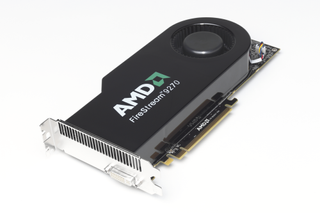ATI Stream: Finally, CUDA Has Competition
In AMD’s Words
You don’t have to spend much time in the GPGPU space, and with the ATI Stream relaunch in specific, before a lot of questions start springing to mind. Several members of AMD’s ATI team were kind enough to field several of my tactless queries with patience and detail. What follows are the high points of this conversation.
Tom's Hardware: Stream’s software (then known as CTM, or close-to-metal) was announced in November 2006. We didn’t see the technology implemented in Catalyst until December 2008, and the 9.5 hotfix brings us to May of 2009. This seems like an unusually long time scale for full deployment.
AMD: I will try to provide some clarification and precision on the different components.
ATI Stream refers to the GPGPU framework (or environment) in both hardware and software, including acceleration of tasks outside the usual game rendering or regular video playback acceleration.
There are two components to ATI Stream: the development environment, which includes a high level language called Brook+, and the runtime component, called Compute Abstraction Layer (CAL). CAL is what has been unified with since the Catalyst drivers of December 2008. Prior to December 2008, there were two separate drivers, one with CAL and one with just the regular Catalyst display drivers. Most ATI Stream applications before the end of 2008 were commercial, such as high performance computing (HPC), oil and gas, academic research, and enterprise video conferencing. These didn’t require regular driver updates as they operated in very stable environments, both for hardware (FireStream) and software.

The reason for unifying the drivers was to put in place the infrastructure for consumers to take advantage of ATI Stream on regular ATI Radeon graphics. As you can see, we’ve had a natural transition from high performance computing to mainstream applications since 2006. Also, ATI Stream drivers also work without major issues for these commercial applications. GPGPU is a new programming model that required not only a drivers infrastructure but also the education of ISVs and developers at the scale of the PC industry to take advantage of it.
The same way we expect a natural transition of the industry to OpenCL & DirectX 11 compute shaders by the end of 2009 to 2010, as developers and ISVs will have programming languages and APIs that are hardware agnostic, which makes is less costly to develop and easier to maintain their code.
Stay on the Cutting Edge
Join the experts who read Tom's Hardware for the inside track on enthusiast PC tech news — and have for over 25 years. We'll send breaking news and in-depth reviews of CPUs, GPUs, AI, maker hardware and more straight to your inbox.
As for the span from last December to this May, the reason it took us several months to come up with an update is that our software teams targeted work that is beyond just fixing an application (ATI Video Converter). They were enabling a new transcoding framework in ATI Stream. The work was a joint effort between different teams in Toronto and Silicon Valley, in addition to working closely with our partner CyberLink in Taipei. All of that had to happen while ensuring the stability of the drivers. It was a big task considering the impact that each change can have on stability.
-
radiowars So..... TBH they both work pretty well, I hope that we don't start a whole competition over this.Reply -
falchard Did someone necro an old topic? I think ATI has been talking about ATI Stream for a while. I know atleast a year since FireStream.Reply -
Andraxxus They're good but hopefully they will manage to improve them more. Competition is good for business.Reply -
IzzyCraft Stream is old but not nearly as old and compatible as CUDA I'd get it a year or two more when more capable cards circulate the market and trickle down to the people before i would call it competition.Reply
Well it's good to see more then just 1 app that supports it. -
ThisIsMe Just for the sake of it, and the fact that many pros would like to know the result, it would be nice to see comparisons like this using nVidia's Quadro cards vs. ATI's FirePro cards.Reply -
ohim why use 185.85 since those drivers are a total wreckReply
http://forums.nvidia.com/index.php?showtopic=96665&st=0&start=0
13 pages with ppl having different problems with that driver -
I think the second graph on the "Mixed Messages" page isn't the right graph.Reply
It's the same graph from the following "Heavier Lifting" page instead of a graph for the 298MB VOB file that should be shown? -
Spanky Deluxe Stream and CUDA are likely to go the way of the dodo soon though. OpenCL's where its at. Unfortunately its a tad hard to get programming with it right now since you need to be a registered developer on nVidia's Early Access Program or you have to be a registered developer with Apple's developer program with access to pre-release copies of Snow Leopard.Reply
Virtually no one will bother using CUDA or Steam after OpenCL's out - why limit yourself to one hardware base after all? It'd be like writing Windows software that only ran on AMD processors and not Intel. Developers will not bother writing for both when they can just use one language that can run on both hardware platforms.
Most Popular

